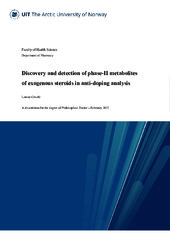Sammendrag
Anti-doping measures are an essential part of professional sports around the world. Anabolic androgenic steroids have been among the most widely used illicit substance classes since the early days of the fight against doping. The conventional method for analysing these substances is gas chromatography combined with mass spectrometry (GC-MS). This approach is sensitive and selective but also very time- and resource-consuming. The main goal of this work was to improve the detection of steroids in a time- and resource-efficient manner by shifting the analysis from GC-MS to liquid chromatography-MS (LC-MS).
In the first part of this thesis, we present a novel, highly functional analytical method for the analysis of steroid phase-II glucuronides in which sample preparation is reduced to a minimum. For this purpose, we developed a simple but powerful online solid-phase extraction method coupled with LC-MS. Two comprehensive validation studies demonstrated the analytical performance of this method. Initially developed for rapid confirmation analysis, this method also showed high potential for identifying and characterizing novel steroid phase-II metabolites.
The aim of the second part of this work was to identify and characterize novel phase-II metabolites of the anabolic androgenic steroids stanozolol and dehydrochloromethyltestosterone using the newly developed method. Both substances are among the most commonly used steroids in professional sports and are of great interest for anti-doping research. For stanozolol, we achieved for the first time to unequivocally confirm four different phase-II glucuronide conjugates using newly synthesized high-quality reference standards. Furthermore, using urine samples from excretion studies, we generated elimination curves for all four metabolites showing elimination windows of up to 28 days. The long excretion time makes this metabolite very interesting for the long-term detection of stanozolol. In the case of dehydrochloromethyltestosterone, we identified two different glucuronide conjugates of the important long-term metabolite M3 for the first time. Due to the lack of reference standards, we used a combination of different analytical approaches to characterize and elucidate the chemical structure of these conjugates. Since these metabolites are well suited for LC-MS analysis, we present for the first time a way to analyse metabolite M3 without requiring a laborious GC-MS approach.
Har del(er)
Paper I: Göschl, L., Gmeiner, G., Enev, V., Kratena, N., Gärtner, P. & Forsdahl, G. (2020). Development and validation of a simple online-SPE method coupled to high-resolution mass spectrometry for the analysis of stanozolol-N-glucuronides in urine samples. Drug Testing and Analysis, 12(8), 1031-1040. Also available in Munin at https://hdl.handle.net/10037/20219.
Paper II: Göschl, L., Gmeiner, G., Gärtner, P., Stadler, G., Enev, V., Thevis, M., … Forsdahl, G. (2021). Stanozolol-N-glucuronide metabolites in human urine samples as suitable targets in terms of routine anti-doping analysis. Drug Testing and Analysis, 13(9), 1668– 1677. Also available in Munin at https://hdl.handle.net/10037/22804.
Paper III: Göschl, L., Gmeiner, G., Gärtner, P., Steinacher, M. & Forsdahl, G. Detection of DHCMT long-term metabolite glucuronides with LC-MSMS as an alternative approach to conventional GC-MSMS analysis. (Accepted manuscript). Now published in Steroids, 180, 2022, 108979, available in Munin at https://hdl.handle.net/10037/24777.


 English
English norsk
norsk
